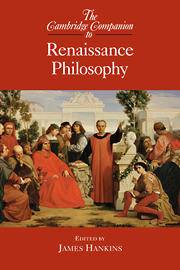Book contents
- Frontmatter
- 1 Introduction
- Part I Continuity and Revival
- 2 The philosopher and Renaissance culture
- 3 Humanism, scholasticism, and Renaissance philosophy
- 4 Continuity and change in the Aristotelian tradition
- 5 The revival of Platonic philosophy
- 6 The revival of Hellenistic philosophies
- 7 Arabic philosophy and Averroism
- 8 How to do magic, and why philosophical prescriptions
- Part II Toward Modern Philosophy
- Appendix: Brief biographies of Renaissance philosophers
- Bibliography
- Index
4 - Continuity and change in the Aristotelian tradition
from Part I - Continuity and Revival
Published online by Cambridge University Press: 28 November 2007
- Frontmatter
- 1 Introduction
- Part I Continuity and Revival
- 2 The philosopher and Renaissance culture
- 3 Humanism, scholasticism, and Renaissance philosophy
- 4 Continuity and change in the Aristotelian tradition
- 5 The revival of Platonic philosophy
- 6 The revival of Hellenistic philosophies
- 7 Arabic philosophy and Averroism
- 8 How to do magic, and why philosophical prescriptions
- Part II Toward Modern Philosophy
- Appendix: Brief biographies of Renaissance philosophers
- Bibliography
- Index
Summary
The predominant view of historians was once that the philosophy of Aristotle, after spreading throughout Latin Christendom in the wake of the great wave of translations from Greek and Arabic begun around 1125, reached its greatest diffusion in the thirteenth century, came to a profound crisis in the fourteenth, and then suffered in the fifteenth under the challenge of Platonism. As a result, Aristotelianism in the Renaissance survived in only a few “conservative” strongholds - such as the universities of Padua, Coimbra, and Cracow - before it was finally swept away by the coming of modern philosophy and science. Thanks to the work of historians like John Herman Randall, Eugenio Garin, Paul Oskar Kristeller, Charles Schmitt, and Charles Lohr, research in the last sixty years has shown that such an image of the development of European thought is so one-sided as to be substantially false. The point here is not merely to insist on the notable expansion of Aristotelianism in the fourteenth century - for in that century, far from declining, Aristotelian philosophy reinforced its position by consolidating its fundamental role in university instruction, by linking its fate to that of influential philosophical and theological schools, and by obtaining for the first time the explicit support of the papacy. One must go still further and insist that, if the greatest intellectual novelty of the Renaissance was the rediscovery of little-known and forgotten philosophical traditions, Aristotelianism nevertheless remained the predominant one through the end of the sixteenth and into the seventeenth century.
- Type
- Chapter
- Information
- The Cambridge Companion to Renaissance Philosophy , pp. 49 - 71Publisher: Cambridge University PressPrint publication year: 2007
- 14
- Cited by

